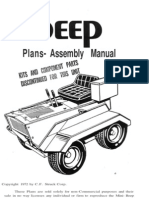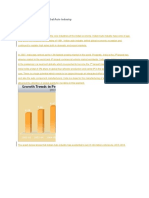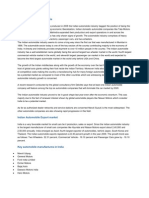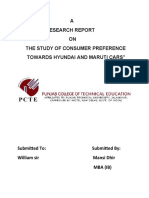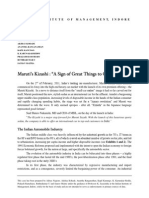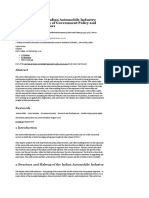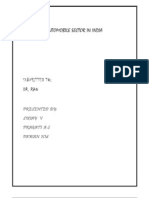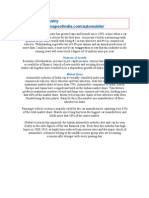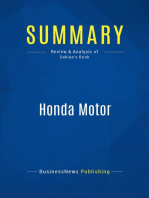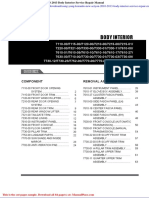Synopsis - Indian Automobile Industry
Synopsis - Indian Automobile Industry
Uploaded by
gunmeetCopyright:
Available Formats
Synopsis - Indian Automobile Industry
Synopsis - Indian Automobile Industry
Uploaded by
gunmeetOriginal Description:
Original Title
Copyright
Available Formats
Share this document
Did you find this document useful?
Is this content inappropriate?
Copyright:
Available Formats
Synopsis - Indian Automobile Industry
Synopsis - Indian Automobile Industry
Uploaded by
gunmeetCopyright:
Available Formats
Synopsis Indian Automobile Industry
With the advent of 21st century, the world has shifted its attention towards Asias
rising superpower, India, due to its rapid economic transformation & putting
India in a bright spot in todays era. India is the 5 th largest car market; 2 nd
largest two-wheeler market; largest tractor and three-wheeler market in the
world. With an annual production of around 25 million vehicles, the automobile
industry contributes 7.2% to the countrys GDP and has a world market share of
around 6%. India is also a notable auto exporter with a growth rate of 1.9% in FY
2016.
The Indian automobile industry can be divided into three phases since the
independence era. Phase 1 (Before 1983) witnessed nationalization and license
raj which hampered the growth rate of the private sector. There were very few
players which were using outdated technologies, with the likes of Ashok Leyland,
Bajaj Auto, HM, Premier among others. Phase II (1983-1992) witnessed the JV of
Maruti Suzuki, todays market leader, with the support of then Indias
government and started production of passenger vehicles. It was this phase
when Indias first affordable car, Maruti 800, was launched. Many such cars were
also exported to Hungary then and the production capacity was 1 lakh units per
annum. Phase 3 (After 1992) was one of the most significant times of Indian
economy. The New Economic Policy allowed the MNCs to invest in India.
Companies like Ford & GM started assembling cars in India. By 2000, India had
around 12 large automobile companies, majority being foreign firms. In 2000,
Maruti became the 1st car company to launch a call center in India.
The two-wheelers account for whopping 80% share in the automobile industry
followed by 14% of the passenger vehicles. Within the passenger vehicles, the
cars are divided into three segments. Segment A (Passenger Cars) including
sedans & hatchbacks like Honda Amaze, Maruti Suzuki Swift/Dzire etc. Segment
B (Utility) includes the Sports Utility Vehicle(SUV) like Maruti Vitara Brezza,
Renault Duster etc. Segment C (Van) includes Maruti Omni, Tata Winger etc. The
SUV share has been rising in the recent times. MSIL has the largest market share
in the passenger vehicles category, i.e., 47.4% followed by Hyundai at 16.6%.
Such a trend is nowhere to be found elsewhere in the world with a single
company owning half of the market, except for Japan where Toyota has 30%
market share. With facts like number of vehicles Fiat sells in a year in India,
Maruti sells them in 4 days and at least 2 Maruti cars being sold every minute
shows the sheer dominance of MSIL.
s
You might also like
- A40Document15 pagesA40Ale100% (4)
- CRF300L - Parts ManualDocument127 pagesCRF300L - Parts ManualDavid MurphyNo ratings yet
- Oleje Silnikowe Zestawienie - Motor Oil Comparison - Piotr TesterDocument4 pagesOleje Silnikowe Zestawienie - Motor Oil Comparison - Piotr Testerdurando87No ratings yet
- Project: (A Case Study of Kanpur Nagar)Document16 pagesProject: (A Case Study of Kanpur Nagar)RAHULNo ratings yet
- 02.product Management at Maruti Udyog LimitedDocument4 pages02.product Management at Maruti Udyog LimitedmuntaquirNo ratings yet
- Project Report On Marketing Strategy of Mahindra AutomobilesDocument81 pagesProject Report On Marketing Strategy of Mahindra AutomobilesManishKumarNabhaites53% (34)
- Speed Twin Clutch DSG S - Tronic AudiDocument88 pagesSpeed Twin Clutch DSG S - Tronic Audikepler2775% (4)
- DC G240 eDocument14 pagesDC G240 eHany Mohamed100% (12)
- Toyota 8FBN PDFDocument7 pagesToyota 8FBN PDFweda utama100% (1)
- Isuzu FSS550 4x4Document4 pagesIsuzu FSS550 4x4Ion Logofătu Albert100% (2)
- Phaeton. Pillar TrimDocument13 pagesPhaeton. Pillar TrimKarl Hubel100% (1)
- Beep Plans CompleteDocument9 pagesBeep Plans Completetaxmac80% (5)
- Audi A4 No. 6 / 1: Convenience ElectricsDocument27 pagesAudi A4 No. 6 / 1: Convenience ElectricsmbpajaNo ratings yet
- 4 Wheeler IndustryDocument7 pages4 Wheeler IndustrySairam MoturiNo ratings yet
- Evolution and Growth of Indian Auto Industry: Research ArticleDocument6 pagesEvolution and Growth of Indian Auto Industry: Research ArticleArshwin SinghNo ratings yet
- Study of The IndustryDocument3 pagesStudy of The IndustryMehul ChauhanNo ratings yet
- 1cm8oaka6 495620Document65 pages1cm8oaka6 495620Anil VermaNo ratings yet
- Automobile Industry ProfileDocument9 pagesAutomobile Industry ProfileMohan Ravi90% (10)
- A Study On Marketing Strategy of MarutiDocument66 pagesA Study On Marketing Strategy of MarutiArun KindoNo ratings yet
- Av Av Av Av Av Av AvDocument2 pagesAv Av Av Av Av Av Avvino22No ratings yet
- Maruti Suzuki Joint VentureDocument11 pagesMaruti Suzuki Joint VentureBitan BanerjeeNo ratings yet
- Car Industry in IndiaDocument15 pagesCar Industry in Indiasaurav0187No ratings yet
- A Research Report ON The Study of Consumer Preference Towards Hyundai and Maruti Cars"Document20 pagesA Research Report ON The Study of Consumer Preference Towards Hyundai and Maruti Cars"Mansi DhirNo ratings yet
- A Research Report ON The Study of Consumer Preference Towards Hyundai and Maruti Cars"Document33 pagesA Research Report ON The Study of Consumer Preference Towards Hyundai and Maruti Cars"Mansi DhirNo ratings yet
- Automobile IndustryDocument15 pagesAutomobile Industryanoop_mishra1986No ratings yet
- Maruti Suzuki India Limited: Sustaining ProfitabilityDocument10 pagesMaruti Suzuki India Limited: Sustaining ProfitabilityVibhusha SinghNo ratings yet
- VikasDocument6 pagesVikasVikas SuleriyaNo ratings yet
- Maruti's KizashiDocument31 pagesMaruti's KizashicloudyappleNo ratings yet
- WCM TVS 106Document45 pagesWCM TVS 106bhagathnagarNo ratings yet
- Converted 1674996547506Document62 pagesConverted 1674996547506kartik rangaNo ratings yet
- Chapter 1: Industrial/Sectoral Scenario: - History / Evolution of The SectorDocument28 pagesChapter 1: Industrial/Sectoral Scenario: - History / Evolution of The SectorDevender DhakaNo ratings yet
- About Maruti Udyog LimitedDocument32 pagesAbout Maruti Udyog LimitedRahul Gupta100% (1)
- FinalDocument61 pagesFinalArpit ChandanaNo ratings yet
- Automotive Industry in India - Wikipedia, The Free EncyclopediaDocument31 pagesAutomotive Industry in India - Wikipedia, The Free EncyclopediaRamesh GowdaNo ratings yet
- Company Background: Hyundai Is A Global Conglomerate Company, Part of The Korean Chaebol, That Was Founded inDocument45 pagesCompany Background: Hyundai Is A Global Conglomerate Company, Part of The Korean Chaebol, That Was Founded inAchal GuptaNo ratings yet
- Pre Owned Cars and BikesDocument83 pagesPre Owned Cars and Bikesdarshan1793No ratings yet
- The Growth of The Indian Automobile Industry - Analysis of The Roles of Government Policy and Other Enabling Factors - SpringerLinkDocument24 pagesThe Growth of The Indian Automobile Industry - Analysis of The Roles of Government Policy and Other Enabling Factors - SpringerLinkRamk TandonNo ratings yet
- rahul project newDocument28 pagesrahul project newPrashanth NairNo ratings yet
- Final Report (Vinay)Document42 pagesFinal Report (Vinay)Richa ShahNo ratings yet
- Industry ProfileDocument9 pagesIndustry ProfileHarivenkatsai SaiNo ratings yet
- Tata Motors Suv Segment ProjectDocument57 pagesTata Motors Suv Segment ProjectmonikaNo ratings yet
- CCC C CCC C CCCC CCDocument11 pagesCCC C CCC C CCCC CCPragati A SubbannavarNo ratings yet
- Indian Automobile IndustryDocument9 pagesIndian Automobile IndustryAayushi PatelNo ratings yet
- A Study of Tata Motors Vehicle Services in Gorakhpur 27-11-2012Document122 pagesA Study of Tata Motors Vehicle Services in Gorakhpur 27-11-2012Shakti Singh RawatNo ratings yet
- Tata Motors and Maruti Suzuki 1Document16 pagesTata Motors and Maruti Suzuki 1unnati guptaNo ratings yet
- Diesel Engine and Car Market in India: Where Does FIAT StandDocument6 pagesDiesel Engine and Car Market in India: Where Does FIAT StandSudhanshu VermaNo ratings yet
- RESEARCH PROJECT Auvesh Buisness EnviroDocument19 pagesRESEARCH PROJECT Auvesh Buisness EnviroDevesh ShuklaNo ratings yet
- Mutual FundDocument61 pagesMutual FundkomalNo ratings yet
- Maruthi SuzukiDocument16 pagesMaruthi SuzukiSreelakshmi.vNo ratings yet
- A Study On Maruti Suzuki Cars and Comparison of Maruti Suzuki Cars With Other Companies CarsDocument80 pagesA Study On Maruti Suzuki Cars and Comparison of Maruti Suzuki Cars With Other Companies CarssspmNo ratings yet
- Automobile IndustryDocument1 pageAutomobile Industrymanishrawat21No ratings yet
- TATA Said When He Launched His Ambitious TATA NANO The People's Car in India On 23 RD MarchDocument18 pagesTATA Said When He Launched His Ambitious TATA NANO The People's Car in India On 23 RD Marchnikhil tandonNo ratings yet
- AFM ProjectDocument40 pagesAFM ProjectAbhinandan SahooNo ratings yet
- Maruti SuzukiDocument81 pagesMaruti SuzukiDinesh RamawatNo ratings yet
- Automobile IndustryDocument4 pagesAutomobile IndustryDarshnaNo ratings yet
- AutomobileDocument7 pagesAutomobileBhupesh TalrejaNo ratings yet
- Maruti Suzuki AnalysisDocument136 pagesMaruti Suzuki AnalysissspmNo ratings yet
- AnkuDocument48 pagesAnkuNahida Tamana KhanNo ratings yet
- Maruti SuzukiDocument76 pagesMaruti SuzukiSIDDHANT SRIVASTAVANo ratings yet
- Maruti SuzukiDocument77 pagesMaruti SuzukiDinesh RamawatNo ratings yet
- In 1952, Tariff Regulations Were Imposed by The Indian Government inDocument2 pagesIn 1952, Tariff Regulations Were Imposed by The Indian Government inravinder9849No ratings yet
- 34 Tvs Apache in ShimogaDocument102 pages34 Tvs Apache in Shimogaavinash_s1302No ratings yet
- Comparative Analysis of Major Fast Food Joints in India Mcdonalds KFC Subway and Burger King 1Document77 pagesComparative Analysis of Major Fast Food Joints in India Mcdonalds KFC Subway and Burger King 1SIDDHANT SRIVASTAVANo ratings yet
- Tata MotorsDocument7 pagesTata MotorsKiranNo ratings yet
- Industry Analysis: Mahindra Scorpio, One of India's Best Selling Indigenously Developed SUVDocument14 pagesIndustry Analysis: Mahindra Scorpio, One of India's Best Selling Indigenously Developed SUVPradeep MonteiroNo ratings yet
- From the Cradle to the Craze: China's Indigenous Automobile IndustryFrom EverandFrom the Cradle to the Craze: China's Indigenous Automobile IndustryNo ratings yet
- India and the Future of G20: Shaping Policies for a Better WorldFrom EverandIndia and the Future of G20: Shaping Policies for a Better WorldNo ratings yet
- Designated Drivers: How China Plans to Dominate the Global Auto IndustryFrom EverandDesignated Drivers: How China Plans to Dominate the Global Auto IndustryNo ratings yet
- Honda Motor (Review and Analysis of Sakiya's Book)From EverandHonda Motor (Review and Analysis of Sakiya's Book)Rating: 2 out of 5 stars2/5 (1)
- Microsoft - Digital StorytellingDocument28 pagesMicrosoft - Digital StorytellinggunmeetNo ratings yet
- Communication For "Be The Lighthouse" Overall Communication From The LeaderDocument5 pagesCommunication For "Be The Lighthouse" Overall Communication From The LeadergunmeetNo ratings yet
- Get in The Habit ParadigmsDocument5 pagesGet in The Habit ParadigmsgunmeetNo ratings yet
- The Five Dysfunctions of A TeamDocument41 pagesThe Five Dysfunctions of A TeamgunmeetNo ratings yet
- B. CommDocument53 pagesB. CommgunmeetNo ratings yet
- Employee Engagement QuestionnaireDocument4 pagesEmployee Engagement Questionnairepushpak_friends883689% (19)
- Literature Review INSURANCEDocument16 pagesLiterature Review INSURANCEgunmeet60% (5)
- 7 Habits Pre-Work DocumentDocument9 pages7 Habits Pre-Work DocumentgunmeetNo ratings yet
- Questionnaire: OpportunitiesDocument5 pagesQuestionnaire: OpportunitiesgunmeetNo ratings yet
- BB SinghDocument15 pagesBB SinghgunmeetNo ratings yet
- AAA - NCNU ERS Programs: Participant's WorkbookDocument17 pagesAAA - NCNU ERS Programs: Participant's WorkbookgunmeetNo ratings yet
- 7 Habits Pre-Work DocumentDocument9 pages7 Habits Pre-Work DocumentgunmeetNo ratings yet
- Baba Banda SinghDocument11 pagesBaba Banda Singhgunmeet100% (1)
- Employee Engagemnt - Group 1 - Section DDocument20 pagesEmployee Engagemnt - Group 1 - Section DAmit SupeNo ratings yet
- Shaheed Banda Singh Bahadur JiDocument10 pagesShaheed Banda Singh Bahadur JigunmeetNo ratings yet
- Total Quality Management 123Document20 pagesTotal Quality Management 123gunmeetNo ratings yet
- Toyota ReportDocument34 pagesToyota Reporttapassya1No ratings yet
- Automatic Boot Open SystemDocument21 pagesAutomatic Boot Open SystemA A.DevanandhNo ratings yet
- Planilha - F B A ComercDocument3 pagesPlanilha - F B A ComercKeice MonnyaNo ratings yet
- CVT Seminar ReportDocument24 pagesCVT Seminar ReportSahil SoodNo ratings yet
- Toyota Land Cruiser 4.5L Diesel VXR A/T My21 4.5L Diesel 2021Document2 pagesToyota Land Cruiser 4.5L Diesel VXR A/T My21 4.5L Diesel 2021shimelsaauscNo ratings yet
- Bar Graphs 2dDocument2 pagesBar Graphs 2dlg.vann.99No ratings yet
- Mountain Bike Action January 2006Document78 pagesMountain Bike Action January 2006Stoleri George100% (2)
- All Tire PatternSize List JUHENG TTIRE Mayllio.21Document12 pagesAll Tire PatternSize List JUHENG TTIRE Mayllio.21number oneNo ratings yet
- X50 BrochureDocument4 pagesX50 BrochureqEINa QistINaNo ratings yet
- Communication Process ManagementDocument115 pagesCommunication Process ManagementJesher KalyanapuNo ratings yet
- Manual de Intretinere Si Reparatii Auto in Limba Romana GratisDocument3 pagesManual de Intretinere Si Reparatii Auto in Limba Romana Gratisviper33_4u25% (4)
- Vehicle Dynamics ThesisDocument42 pagesVehicle Dynamics ThesisTochi Krishna Abhishek100% (1)
- 05 VW Full Veh ModelsDocument18 pages05 VW Full Veh ModelsjdiezNo ratings yet
- STC750Document12 pagesSTC750Dhana Shekar67% (3)
- Dump FM 350 PL - 1742889685Document1 pageDump FM 350 PL - 1742889685tizar wahyudiNo ratings yet
- Service Doosan Dl300Document1 pageService Doosan Dl300Mahmmod Al-Qawasmeh100% (1)
- Number OEM Investigate Applicable Model PictureDocument7 pagesNumber OEM Investigate Applicable Model PictureMark Mai100% (1)
- Ssang Yong Korando New Actyon 2010 2013 Body Interior Service Repair ManualDocument8 pagesSsang Yong Korando New Actyon 2010 2013 Body Interior Service Repair Manualhenry100% (65)
- XGE105Document2 pagesXGE105abangNo ratings yet
- Parkers Nissan Interstar Van 2003 - 2011Document8 pagesParkers Nissan Interstar Van 2003 - 2011devil fixitNo ratings yet











